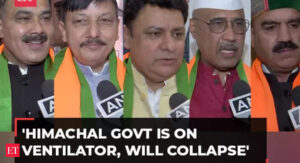Brahmanism and Leftism: Why IITs selected to steer clear of Times Varsity rankings this yr
4 min readA complete of 71 Indian universities have made it to the Times Higher Education (THE) World University Rankings 2022, up from 63 final yr. However, none of them has managed to breach the top-300 barrier because the Indian Institute of Science (IISc) – an everyday within the checklist, sits within the 301-350 band for a 3rd consecutive yr. IIT-Ropar and JSS Academy of Higher Education discover themselves in between the 351-400 band, whereas IIT Indore comes on the fourth spot, ranked between 401 and 500. However, one could be stunned to see not one of the older IITs– Mumbai, Delhi, Roorkee and so forth. within the checklist. This is as a result of, these institutes have boycotted the ‘THE’ rankings for the second consecutive yr, owing to the dearth of transparency within the rating methodology and parameters.IITs boycotted THE (Text Only)Last yr, the seven older IITs didn’t ship their respective information for 2018 and 2019, for the 2020 rankings while citing, “The leading IITs i.e. IIT Bombay, IIT Delhi, IIT Guwahati, IIT Kanpur, IIT Kharagpur, IIT Madras and IIT Roorkee have decided to not participate in any of the Times Higher Education (THE) – World University Rankings this year (2020). These IITs will reconsider their decision next year if Times Higher Education is able to convince them about the parameters and transparency in their ranking process,”The then Human Resource Development Minister Ramesh Pokhriyal ‘Nishank’ supported the IITs choice by stating that THE rating lay an excessive amount of emphasis on notion. He stated, “Times and QS ranking downgrade our institutions on the basis of perception, I do not agree with that. Our institutions are doing a lot of good research, we cannot be judged only on the basis of perception,”IIT Delhi director Ramgopal Rao on social media echoed comparable sentiments and stated that THE scores didn’t signify the true rating of establishments. “In three of the ranking parameters, such as international students, international faculty and faculty-student ratio, our institutions score close to zero points. We don’t score well on perception-based parameters on a global scale.”The layman may miss what Ramgopal Rao meant by ‘..we don’t rating nicely on perception-based parameters on a worldwide scale because the college ‘ but a close look at the workings of THE parameters gives us a sneak peek into the actual methodology of assigning rankings.According to the literature available across the internet, THE ranks the universities based on performance indicators, grouped into five parameters: teaching (the learning environment), research (the volume, income and reputation), citations (or the research influence), international outlook (of staff, students and research) and industry income (that is the knowledge transfer).It all boils down to the opinions of few chosen ‘intellectuals’Simply put, the Times Higher Education (THE) World University Rankings are constructed on the insights of a consultant pattern of supposed world consultants. THE conducts an Academic Reputation Survey, which in accordance to its web site types the inspiration for these rankings.Meaning, the respondents who won’t have been in contact with the work completed by the IITs or different Indian establishments are requested to grade their top-15 establishments. No reasoning, no nothing in any way, merely primarily based on the notion of few chosen elites, a significant a part of the rankings is set.A mass marketing campaign to focus on IITsThe huge, ubiquitous names akin to Harvard and Stanford obtain rather more traction owing to their historical past and total reputation. Meanwhile, the IITs, which don’t have huge advertising and marketing or PR equipment, are likely to lag. This notion is what Ramgopal Rao talked about whereas citing the phrase, “where the universities do not tend to perform well.”And it’s comprehensible reasoning, for one, there was a concerted try in latest occasions to malign the picture of IITs. Routine accusations of Brahminism are hurled at these trusted and credible establishments.The Indian left cabal in affiliation with the worldwide left media describes IIT as the house of Brahmins. It is alleged that non-Savarnas are intentionally failed within the high institutes of the nation. These allegations are false as it’s one factor to crack the doorway exams with the assistance of the quota system however, one other to crack the tutorial exams the place the one advantage involves the fore.In July, Vipin P. Veetil, resigned as an assistant professor at IIT Madras citing he confronted caste-based discrimination and since then, the liberal media has dubbed the complete IIT world as the house of Brahminical patriarchy. However, international establishments akin to Time used to sneering and looking out down upon India to exploit the chance to downgrade the rankings. It wouldn’t matter that routine information of racism in opposition to Asians comes from the top-ranking establishments of the US and the UK however, as a result of India and its high Universities can’t be pushed additional, the agenda continues.The Indian Institutes of Technology are glorious tutorial establishments with the best-performing college students within the discipline and really nicely achieved colleges. So, within the grander scheme of issues, these rankings don’t matter a lot however what issues is the skewed methodology that Times makes use of to color a false image. Those in search of rankings, right here in India, can merely go and do their analysis primarily based on India’s personal National Institutional Ranking Framework, or NIRF rankings.






